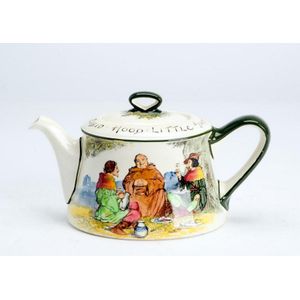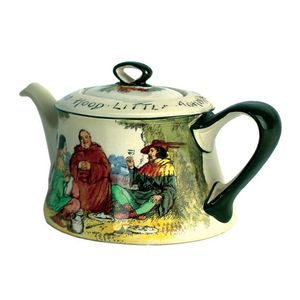Art Deco Lustre Teapot with Trivet
You must be a subscriber, and be logged in to view price and dealer details.
Subscribe Now to view actual auction price for this item
When you subscribe, you have the option of setting the currency in which to display prices to $Au, $US, $NZ or Stg.
- Trivets - Originally a trivet was a three-legged stand placed in front of fire on which to put pots and utensils, in use from the seventeenth century. They were usually made of wrought iron, and later of brass. However, the use of the word has been extended to describe any type of stand to place a hot object on, such as a teapot, iron or jug to prevent the heat from the object reaching the surface underneath. They may be made from ceramic, silver, wood or brass.
- Lustre Ware - Lustre decoration on ceramics is created by painting a thin deposit of metal oxide such as gold, silver or copper onto the surface, and then firing the item again, so that metal oxide forms a thin film on the surface. The finished effect is a shiny metallic surface. The technique was used in the 19th century by potteries such as Crown Devon, Grimwades, Maling, and Royal Doulton. However the best known use was by Wedgwood for its Fairyland lustre.
- Art Deco Period - The Art Deco period was a cultural movement that emerged in the 1920s and 1930s, and was characterized by its emphasis on modernism, luxury, and elegance. The name "Art Deco" comes from the Exposition Internationale des Arts Décoratifs et Industriels Modernes, a large exhibition held in Paris in 1925 that showcased the latest trends in decorative arts.
Art Deco was a reaction against the ornate and elaborate styles of the previous era, and reflected a new modern sensibility. It was characterized by streamlined, geometric shapes, bright colours, and the use of new materials such as chrome, glass, and Bakelite. Art Deco designers sought to create a sense of luxury and sophistication, often incorporating expensive materials such as ivory, marble, and rare woods.
Art Deco had a significant impact on a wide range of artistic fields, including architecture, fashion, graphic design, and interior design. Some of the most iconic examples of Art Deco architecture include the Empire State Building in New York City, the Hoover Building in London, and the Palais de Chaillot in Paris.
The Art Deco period came to an end in the 1940s, as World War II and changing cultural trends led to a shift in artistic styles. However, Art Deco remains an important influence on design and art, and continues to be celebrated for its modernist sensibility and glamorous aesthetic.
This item has been included into following indexes:
Visually similar items

A late 19th/early 20th century Japanese cloisonne lidded pot, with two handles. Extensive floral and geometric decoration. Height 11 cm

Antique Chinese miniature Cloisonne teapot, with gold fleck decoration, late 19th century

Royal Doulton porcelain teapot 'Under The Greenwood Tree. Robin Hood, Little John & Jovial Friar Tuck'. 13 cm

A Royal Doulton 'Under the Greenwood Tree Lidded Teapot', tanned coloured decoration of Robin Hood, etc., oval form, D3751, shape #30
